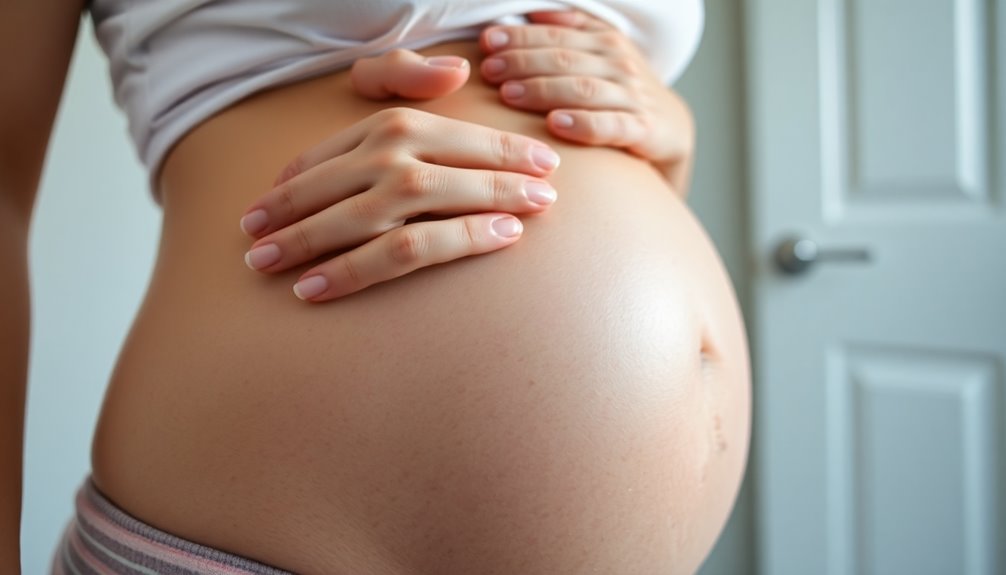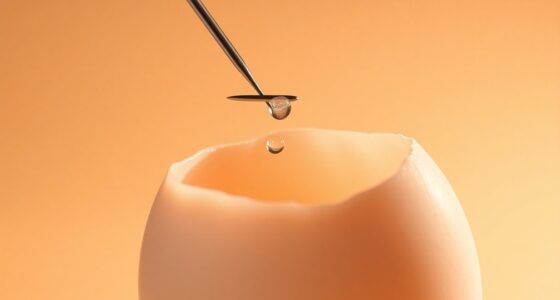Urinary incontinence during pregnancy can be shocking, but you're not alone; nearly one-third of women experience it right after delivery. Increased pressure from your growing uterus and weakened pelvic floor muscles lead to involuntary leakage, especially when you cough, laugh, or exercise. While it may seem challenging, most women see symptoms improve within weeks postpartum. Want to know more about causes, treatments, and how to manage this common issue? There's plenty to explore on this topic!
Key Takeaways
- Urinary incontinence, especially stress urinary incontinence (SUI), affects many pregnant women due to increased bladder pressure from the growing uterus.
- Symptoms often start in the first trimester and may worsen by the third trimester, causing involuntary leakage during physical activities.
- Weakened pelvic floor muscles, hormonal changes, and vaginal delivery can contribute to the risk of developing incontinence during and after pregnancy.
- Kegel exercises and behavioral methods can help manage symptoms effectively, with many women experiencing improvement within weeks postpartum.
- Consulting healthcare providers is essential for personalized strategies and support, especially if incontinence persists beyond six weeks after delivery.
What Is Incontinence During Pregnancy?

Urinary incontinence during pregnancy, especially stress urinary incontinence (SUI), is a common issue that affects many expecting individuals.
Urinary incontinence, particularly stress urinary incontinence, is a frequent concern for many pregnant individuals.
As your pregnancy progresses, increased pressure on the bladder from the growing uterus can weaken your pelvic floor muscles, leading to bladder control problems. You might experience involuntary leakage during activities that raise abdominal pressure, like coughing, sneezing, laughing, or exercising.
Incontinence can start as early as the first trimester and may worsen as you enter the third trimester. While urinary incontinence is often temporary, it can still impact your daily life.
Incorporating exercises to strengthen your pelvic floor muscles can help manage symptoms, making your pregnancy experience more comfortable and enjoyable.
What Are the Signs of Pregnancy Incontinence?

How can you tell if you're experiencing pregnancy incontinence? Many pregnant women experience signs like dribbling or leakage when you cough, sneeze, laugh, or exercise, which is known as stress urinary incontinence (SUI).
You might also feel a sudden, uncontrollable urge to urinate, leading to frequent bathroom visits throughout the day. These symptoms can start as early as the first trimester, but they often worsen as your pregnancy progresses, especially in the third trimester when there's increased pressure on your bladder.
Additionally, you may notice leakage or dribbling between bathroom visits, suggesting a need for proactive management of your pelvic muscles.
Don't hesitate to discuss any incontinence symptoms with your healthcare provider for support and solutions.
What Causes Bladder Control Loss in Pregnancy and After Childbirth?

As your pregnancy progresses, increased pressure from the growing fetus can considerably impact your bladder's function and capacity. This pressure often leads to bladder control loss as your pelvic floor muscles weaken due to hormonal changes.
When you experience urinary incontinence, it's crucial to recognize that vaginal delivery can further stretch these muscles and potentially damage pelvic nerves, increasing the likelihood of issues postpartum. Prolonged pushing during delivery heightens this risk, especially for postpartum women.
Additionally, factors like pre-existing incontinence, advanced maternal age, and excess weight gain can make you more susceptible to bladder control loss.
Pre-existing incontinence, age, and weight gain increase the risk of bladder control loss during pregnancy.
To combat these effects, incorporating Kegel exercises into your routine can help strengthen your pelvic floor muscles and improve bladder control.
How Are Bladder Control Problems During or After Pregnancy Diagnosed?

When you're dealing with bladder control issues during or after pregnancy, your healthcare provider will typically start with a thorough physical examination to evaluate your pelvic floor function.
They might also conduct bladder stress tests to see how your body responds to certain activities, like coughing or sneezing.
Physical Examination Techniques
To properly diagnose bladder control problems during or after pregnancy, healthcare providers typically start with a thorough physical examination. They assess your pelvic floor strength and function, which plays a vital role in urinary incontinence.
Here's a brief overview of the examination techniques:
| Technique | Purpose | Key Considerations |
|---|---|---|
| Medical History | Identify risk factors | Previous incontinence |
| Urinalysis | Rule out urinary tract infections | Symptoms of UTIs |
| Kegel Assessment | Evaluate pelvic floor strength | Effectiveness of exercises |
These steps help determine the underlying causes of your symptoms, making it easier to develop a tailored treatment plan.
Bladder Stress Testing
After evaluating your pelvic floor strength and conducting a thorough medical history and urinalysis, bladder stress testing can provide further insight into urinary incontinence during or after pregnancy.
This diagnostic procedure assesses your bladder's ability to hold urine under pressure, simulating activities like coughing or sneezing. During the test, your healthcare provider observes for any involuntary loss of urine, helping identify the type and severity of your bladder control issues.
It's especially useful for diagnosing stress urinary incontinence (SUI), common in those with weakened pelvic floor muscles.
The results of bladder stress testing guide your treatment options, which may include pelvic floor exercises or surgical interventions tailored to your specific diagnosis.
How Are Bladder Control Problems During Pregnancy Treated?

When it comes to treating bladder control problems during pregnancy, you have several options.
Non-surgical treatments, lifestyle changes, and even surgical interventions might be considered, depending on your situation.
It's important to explore these avenues to find what works best for you.
Non-Surgical Treatment Options
Urinary incontinence during pregnancy can be distressing, but several effective non-surgical treatment options are available to help manage the symptoms.
Kegel exercises are a great place to start; by strengthening the pelvic floor, you can better support your bladder and urethra. Aim for 10 repetitions three times a day for best results.
Behavioral methods like bladder training and timed voiding can also improve your control over urination by gradually extending the intervals between bathroom visits.
Additionally, pelvic floor physical therapy offers personalized management of incontinence. If needed, medications can enhance bladder capacity and reduce urgency.
Exploring these non-surgical treatment options can greatly alleviate urinary incontinence during your pregnancy, making the experience more comfortable.
Lifestyle Modifications for Management
Managing bladder control problems during pregnancy involves several effective lifestyle modifications that can greatly improve your comfort. Here are some key strategies to evaluate:
- Maintain a healthy weight: Even a 10% weight reduction can alleviate pressure on your bladder.
- Limit bladder irritants: Cut back on caffeine and avoid spicy or acidic foods to reduce urgency.
- Engage in pelvic floor exercises: Kegel exercises, with 10 repetitions held for 5 to 10 seconds, three times daily, can strengthen your pelvic muscles.
- Adopt bladder training techniques: Gradually extend the time between bathroom visits to enhance bladder control.
Don't forget to consult your healthcare providers for tailored advice on dietary and lifestyle modifications to manage urinary incontinence effectively during pregnancy.
Surgical Intervention Possibilities
If conservative measures like lifestyle changes and pelvic floor exercises haven't provided relief from bladder control issues during pregnancy, surgical intervention may be a viable option.
Surgical interventions for stress urinary incontinence (SUI) include synthetic mesh sling surgery, Burch colposuspension, and traditional pubovaginal sling procedures, all aimed at restoring normal bladder function.
Typically, these options are considered after the postpartum period when hormonal changes stabilize and persistent incontinence greatly impacts your quality of life.
Before undergoing surgery, it's essential to have a thorough evaluation by healthcare providers to assess your unique circumstances.
Keep in mind that while these procedures can be effective, they also carry risks and potential complications, so discuss all benefits and risks in detail before making a decision.
Can Pregnancy-Related Loss of Bladder Control Be Prevented?

How can you prevent pregnancy-related loss of bladder control? By taking proactive steps, you can strengthen your pelvic floor muscles and reduce the risk of urinary incontinence. Here are some effective strategies:
- Perform Kegel exercises regularly to strengthen your pelvic floor muscles.
- Maintain a healthy weight; even a 10% reduction can alleviate bladder pressure.
- Limit bladder irritants like caffeine and spicy foods to decrease incontinence symptoms.
- Engage in bladder training to extend bathroom intervals and improve bladder control.
Additionally, consulting with healthcare providers can provide personalized strategies and early interventions tailored to your needs.
How Long Does Incontinence Last?

Urinary incontinence during pregnancy is often a temporary condition, with many women regaining normal bladder control within three to six months after giving birth.
About one-third of women may experience urinary incontinence immediately after delivery, but most notice significant improvement in the following weeks.
Recovery time varies and can be influenced by several risk factors, including the type of delivery and the size of your baby.
If you'd prolonged pushing during labor, you might experience symptoms for longer.
It's crucial to consult with your healthcare provider if incontinence persists beyond six weeks postpartum.
Strengthening your pelvic floor muscles can aid recovery, helping you regain control and improve your overall bladder health.
Frequently Asked Questions
Can Miscarriage Cause Urinary Incontinence?
Miscarriage itself doesn't directly cause urinary incontinence, but the hormonal and physical changes you experience can impact your pelvic floor muscle strength.
If you've had previous pregnancies, weakened muscles may contribute to stress urinary incontinence.
Additionally, the emotional and physical stress from a miscarriage might lead you to neglect pelvic floor exercises.
It's important to seek medical advice for any urinary concerns and to discuss pelvic floor rehabilitation as you recover.
How Early Does Urinary Incontinence Start in Pregnancy?
Imagine sneezing and suddenly feeling a little leak; it's more common than you think during pregnancy.
Urinary incontinence can start as early as the first trimester, affecting about one-third of pregnant individuals. You might experience stress urinary incontinence, especially during activities like coughing or exercising.
As your pregnancy progresses, the pressure from your growing uterus and hormonal changes can increase urgency and frequency, making it essential to communicate with your healthcare provider.
Why Have I Suddenly Lost Control of My Bladder?
You might've suddenly lost control of your bladder due to the increased pressure your growing fetus places on your bladder, especially in the third trimester.
Hormonal changes can weaken your pelvic floor muscles, making it harder to maintain control.
If you've had previous issues or other risk factors like obesity or age, these could also contribute.
It's common, so don't hesitate to discuss your concerns with your healthcare provider for support and advice.
Why Does It Feel Like I Peed Myself While Pregnant?
You might feel like you've peed yourself because your growing belly is pressing down on your bladder, making it hard to hold it in.
Picture sneezing or laughing, and suddenly, you're caught off guard. Hormonal shifts can weaken your pelvic muscles, too, adding to the urgency.
As your pregnancy progresses, you may notice this sensation more, especially with the frequent trips to the bathroom.
It's common, but don't hesitate to talk to your doctor about it.
Conclusion
To sum up, urinary incontinence during pregnancy might feel like a surprise twist in your own story, much like a plot twist in a gripping novel. While it can be alarming, remember you're not alone, and solutions are within reach. By understanding the signs, causes, and treatments, you can take charge of your journey. So, embrace this chapter with confidence, knowing that every hero faces challenges, but with the right support, you can emerge victorious!








